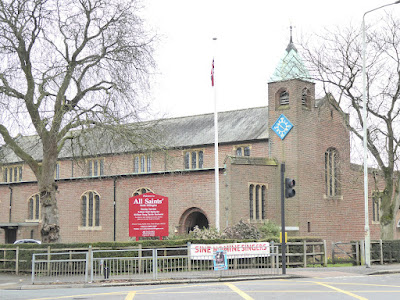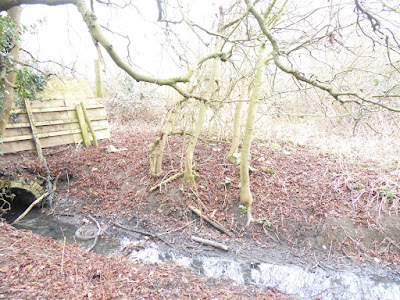This is the penultimate station on the Uxbridge branch of the Metropolitan line and also the Piccadilly Line. The station was resited in 1992 and is the most recently constructed Metropolitan line station. To enable the widening of the A40 (Western Avenue) at Hillingdon Circus, the old station was demolished and a new station built to the South. The word Swakeleys on the roundel refers to the nearby junction of the A40.
Going up the steps from the platform the first thing I noticed was the noise. It was coming from the A40. All the time I was walking around the area the noise was ever present. The A40 is a major road between London and Wales.
You can see here the railway bridge crossing the A40.
I do like the blue clock on the church. I have seen a few churches in this area with similar clocks. The church was first consecrated in 1933, but the clock is a more recent addition in 2018
This won't be a long post as there wasn't much to see. The main town in this area is Uxbridge, the next station on the line which I intend visiting after my brief visit to Hillingdon. I am still very much in Metroland where the railway bought up adjacent land and built land on it promoting living a rural life but working in a city.
A short walk from the station is Hillingdon Court Park. With its football pitches, tennis courts, play area, formal gardens and woodland, it seems to cater for all the community.
 I walked back towards the station past this row of mock tudor shops. It was still quite early on a Sunday morning so most of them were closed.
I walked back towards the station past this row of mock tudor shops. It was still quite early on a Sunday morning so most of them were closed.Crossed the bridge over the A40. Doesn't look that busy when this photo was taken.
I followed the signs to Swakeleys Park which wasn't really that far from the station.
Swakeleys Park is part of the former Swakeleys estate which covered 429 acres. The Jacobean mansion Swakeleys dominated the landscape. The park itself was privately owned until the 1920s, when it was given to the council to be preserved as public open space.
More recently, additional recreational facilities have been added to the park with this outdoor gym and a children's playground.
Swakeleys House was built between 1629 and 1638 and is an example of Jacobean architecture. It is a Grade I listed building. The house has been open to the public on Open House weekends but in 2015 the property was put on the market for £45 million. In winter you can just about see the house from the park
On the way back to the station I walked past these gates which I assume is the driveway to Swakeleys House. Other than the noise from the A40 this seemed a very pleasant residential area. Houses were all different. Many had large gardens at the front and I assume at the back as well. There were lots of green spaces and the wide tree lined roads gave a feeling of space. Just a pity about the noise.






































